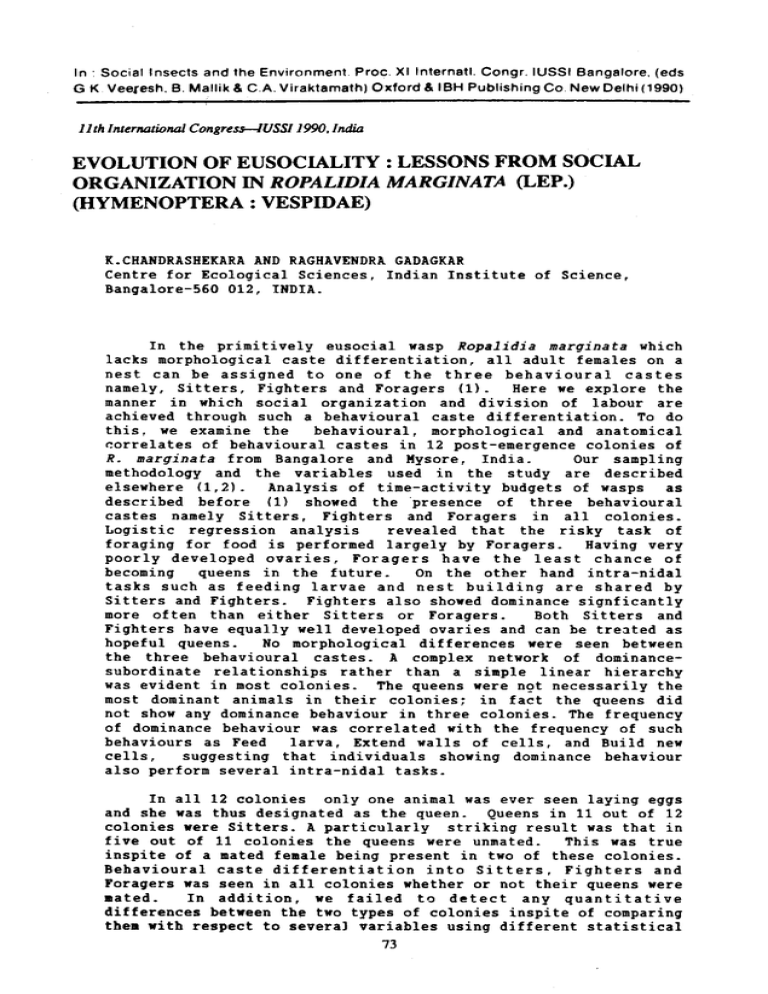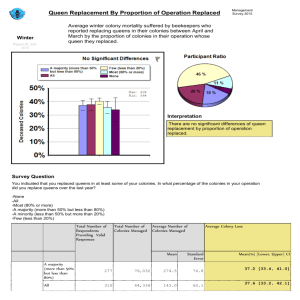In. Social Insects and the ... Proc XI Internatl. Congr. IUSSI ... (eds G K Veeresh. B. Mallik ...
advertisement

In. Social Insects G K Veeresh. and the Environment B. Mallik & CA. Viraktamath) Proc XI Internatl. Oxford Congr. & IBH Publishing IUSSI Bangalore. (eds Co New Delhi (1990) i 11th1nternational Congress-/USSll990,/ndia EVOLUTION OF EUSOCIALITY : LESSONS FROM SOCIAL ORGANIZATION IN ROPALIDIA MARGINATA (LEP.) (HYMENOPTERA: VESPIDAE) K.CHANDRASHEKARA AND RAGHAVENDRA GADAGKAR Centre for Ecological Sciences, Indian Institute Bangalore-560 012, INDIA. of Science, In the primitively eusocial wasp Ropalidia marginata which lacks morphological caste differentiation, all adult females on a nest can be assigned to one of the three behavioural castes namely, Sitters, Fighters and Foragers (1). Here we explore the manner in which social organization and division of labour are achieved through such a behavioural caste differentiation. To do this, we examine the behavioural, morphological and anatomical ~orrelates of behavioural castes in 12 post-emergence colonies of R. marginata from Bangalore and Mysore, India. Our sampling methodology and the variables used in the study are described elsewhere (1,2). Analysis of time-activity budgets of wasps as described before (1) showed the presence of three behavioural castes namely Sitters, Fighters and Foragers in all colonies. Logistic regression analysis revealed that the risky task of foraging for food is performed largely by Foragers. Having very poorly developed ovaries, Foragers have the least chance of becoming queens in the future. On the other hand intra-nidal tasks such as feeding larvae and nest building are shared by Sitters and Fighters. Fighters also showed dominance signficantly more often than either Sitters or Foragers. Both Sitters and Fighters have equally well developed ovaries and can be treated as hopeful queens. No morphological differences were seen between the three behavioural castes. A complex network of dominancesubordinate relationships rather than a simple linear hierarchy was evident in most colonies. The queens were ngt necessarily the most dominant animals in their colonies; in fact the queens did not show any dominance behaviour in three colonies. The frequency of dominance behaviour was correlated with the frequency of such behaviours as Feed larva, Extend walls of cells, and Build new cells, suggesting that individuals showing dominance behaviour also perform several intra-nidal tasks. In all 12 colonies only one animal was ever seen laying eggs and she was thus designated as the queen. Queens in 11 out of 12 colonies were Sitters. A particularly striking result was that in five out of 11 colonies the queens were unmated. This was true inspite of a mated female being present in two of these colonies. Behavioural caste differentiation into Sitters, Fighters and Foragers was seen in all colonies whether or not their queens were mated. In addition, we failed to detect any quantitative differences between th~ two types of colonies inspite of comparing the. with respect to severa] variables using different statistical 73 methods. Our results suggest that development of a female's ovaries become queens, prevent nestmates normal social organization. mating is not essential for the and that unmated females can from laying eggs and maintain R. marginata is characterized by perennial indeterminate colony cycles and undergoes frequent queen replacements. This provides opportunities for other individuals to become queens. Such opportunities for future reproduction are expected to result in behaviours that are moulded by selection both at the colony level and at the individual level. Indeed, we suggest that behavioural caste differentiation into Sitters, Fighters and Foragers is a manifestation of selection acting at both kin or colony level and at the individual level. Foragers who appear to have the least chance of reproduction take up the risky task of foraging and enhance colony fitness and thereby also maximize their own inclusive fitness. Sitters and Fighters on the other hand share intra-nidal tasks and thereby enhance colony fitness and their own inclusive fitness. But by being dominant, Fighters appear to increase their chances of becoming queens in the future. By avoiding foraging and dominant acts, Sitters appear to conserve energy and thus pursue an alternate strategy of enhancing their chances of becoming queens in the future. Most individuals thus try to maximize their own chances of future reproduction without hurting the colony's intere.sts too much. When an opportunity for direct reproduction arises due to the death or ageing of a queen however, we might expect individuals to sacrifice the interests of the colony to become queens and gain direct fitness. That such a scenario is possible is suggested by the fact that unmated females can become queens even in the presence of mated females who may make better queens for the colony. Worker-brood relatedness is e~pected to be low in R. marginata both because of multiple mating by the queen (3) and frequent queen replacements (4). Owing to these reasons it has been argued (5) that indirect fitness gained by workers is unlikely to maintain group life in this species and that mutualistic interactions among hopeful reproductives are more important for the evolution of group life. Such an ar~uement is consistent with results presented here which show that division of labour and social organization are achieved through behavioural caste differentiation and not, as in many species studied, through a dominance hierarchy led by a despotic queen suppressing all her nestmates into worker roles. 1. 2. Gadagkar, R. and N.V. Joshi. 1983. Anim. Behav. 31:26-31. Chandrashekara, K. and R. Gadagkar. 1987. Natl. Symp. Social Insects, Univ. Agril. Sciences, Bangalore, India. 3. Muralidharan, K., Shaila, M. S. and R. Gadagkar. 1986. J. Genet. 65:153-158. 4. Gadagkar R., Chandrashekara, K., Swarnalatha Chandran, and Seetha Bhagavan. this volume. 5. Gadagkar, R. In: Social Biology of Wasps, K.G. Ross, and R.W. Matthews, Eds., Cornell University Press, New York. in Press. 74
